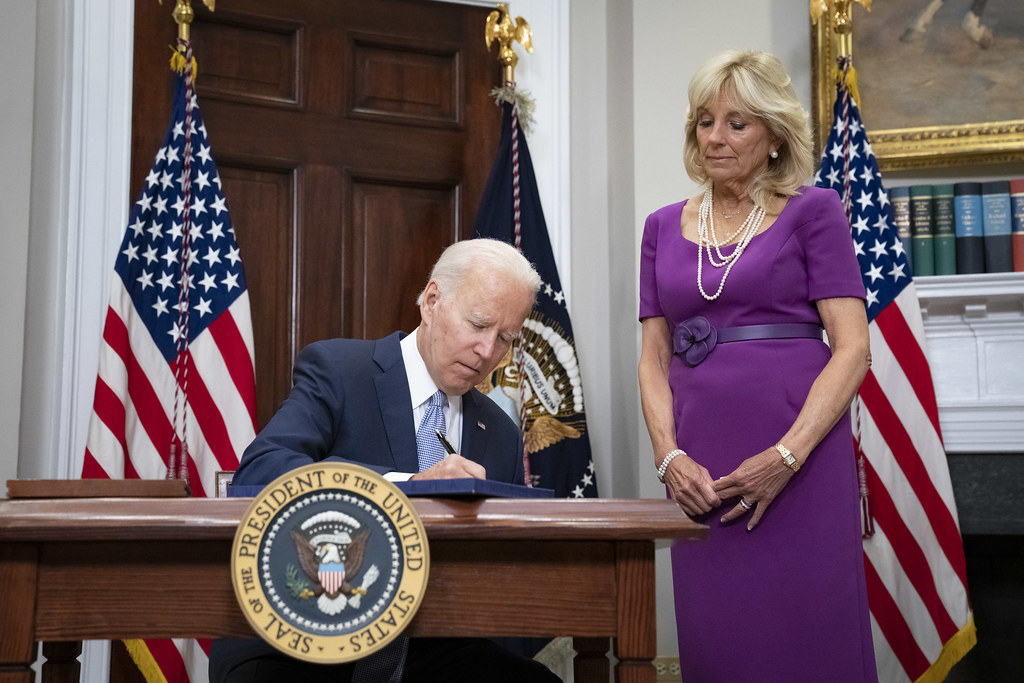In the wake of a spate of mass shootings, including the horrific tragedy that left 19 children and two teachers dead in Uvalde, Texas, Congress broke a longstanding stalemate over firearms regulation and passed the Bipartisan Safer Communities Act — the first time since 1994 that lawmakers in Washington came together on meaningful gun control legislation. Along with the much-publicized funding for red-flag laws in the states and more robust background checks for firearms purchases, a little-reported aspect of the new legislation constitutes a broad expansion of federal criminal laws governing firearms and their penalties.
As federal public defenders in Baltimore, Detroit, and Boston, we fear these provisions will not make our communities safer, or even be used in service of stopping tragedies like the one at Robb Elementary School in Uvalde. Instead, these new laws will broaden federal prosecutors’ already significant discretion to bring harsh federal penalties to bear in cases that would and should otherwise be left to state and local prosecutions. And if past practice is any guide, there is ample reason to fear that these new tools will be used as existing federal authorities have been used for decades: to target overpoliced and disenfranchised Black and Brown communities for simple possession offenses.
There has been little to no public discussion, much less awareness, of the scope or potential impact of these provisions. That these changes may have escaped much notice is not surprising: The gun law was passed under a cloak of secrecy and in a flurry of activity in the month following the Uvalde shooting. The horror of the tragedy, as The New York Times put it, “galvanized a bipartisan group of lawmakers” to act, and in a month’s time legislators passed an 80-page bill with virtually no debate or deliberation. The text of the bill was released on June 21; the Senate passed the bill without amendment two days later, with the House of Representatives following suit the next day. By June 25, President Biden had signed the bill into law. The bill was compiled without consultation with experts from the criminal defense bar and even congressmen voting yes complained about the lack of time to consider the likely “unintended consequences.”
We all want effective solutions for our children and society. But having seen the consequences of decades of wrongheaded federal attempts to criminalize our way out of gun violence, we also know the perils of rushed legislation that doubles down on a failed strategy. Lawmakers and citizens must do better when we know better; we cannot let this new law lead us down the same dangerous road as previous reactionary legislation.
The War on Guns
For public defenders like us, it is nearly impossible to miss the parallels between the new gun law and the Anti-Drug Abuse Act of 1986, one of the most destructive laws ever passed in the United States. This law, too, was hurried through Congress in the wake of a horrific tragedy: the 1986 cocaine overdose death of college basketball star Len Bias. His death sparked an outpouring of grief, public outrage, and panic, with “ the papers … screaming for blood.” Congress heard these screams and reacted. Soon after Bias’s death, then-House Speaker Tip O’Neill issued a clear directive to his fellow Democrats: “Write me some goddamn legislation.” The result was a frenzy of legislative activity that dispensed with much of the usual deliberative process. As Eric Sterling, who served as counsel to the House subcommittee that drafted the ADAA, recalled in 2011:
Usually when you want to introduce a new bill, you sit down and carefully write the policy. Are we clear on what the implications are? You write a draft and maybe circulate it around for ideas. You ask federal judges, prisons, prosecutors, U.S. attorneys, the DEA, law professors, sentencing commissions, criminal defense lawyers and the ACLU how it will affect things. You have hearings. All of this was skipped [for the drug sentencing bill]. Both sides were trying to be quicker and tougher than the other.
The devastating and unintended consequences of this failed legislation reverberate today. The ADAA created harsh mandatory minimums for a variety of offenses and introduced the now-discredited 100-to-1 ratio between crack and powder cocaine into the federal penal code. These drug laws sparked an explosion in the federal prison population. As Sterling wrote in 2006, the legislative history of the ADAA now symbolizes for many “the danger that arises when a powerful symbol overwhelms careful judgment about what ought to be the law.” More than 25 years later, Congress’ haste has proven nearly impossible to unwind. And despite a 2010 reform and widespread bipartisan consensus that crack is not any more dangerous than powder cocaine, an 18-1 ratio for sentencing between crack and powder cocaine still exists in federal law.
As if history were repeating itself, Congress quietly tucked into the new law a long list of new firearm offenses and increased statutory penalties that, combined, represent one of the starkest expansions in federal criminal law in recent memory. This new act vastly expands the existing power of federal authorities to prosecute and punish run of the mill firearm possession, essentially turning nearly every local or state felony firearm offense into a potential federal case — with the threat of massive federal sentences. Indeed, the law enhances the penalty for possession of firearms by “prohibited persons” from 10 to 15 years of imprisonment and expands the reach of the federal death penalty and the availability of mandatory life sentences — by adding the new “trafficking” and “straw purchasing” offenses to the definition of “racketeering activity.” When prosecutors can choose to bring federal charges that carry longer federal sentences and mandatory minimums, they can coerce guilty pleas, not only once the case is in federal court, but also in state court with the threat of federal prosecution if an individual exercises his constitutional right to proceed to trial.
As if history were repeating itself, Congress quietly tucked into the new law a long list of new firearm offenses and increased statutory penalties that, combined, represent one of the starkest expansions in federal criminal law in recent memory.
These increased penalties for conduct that was already criminalized ignore that the overwhelming majority of guns used to commit mass shootings are purchased legally. In other words, this vast expansion in federal criminal liability is not a response to the mass shooting tragedies that sparked the law. But these new provisions can and will be used to exacerbate mass incarceration in countless ways that never make the headlines, potentially for decades to come.
Severe Sentences Won’t Stop the Violence — and Will Exacerbate Racial Disparities in Federal Prisons
Public defenders know, as one of our own wrote a couple of years ago, that “the empirical research on the relationship between federal gun possession prosecutions and crime rates strongly suggests that the prosecutions have little to no impact.” Why? The answer is simple: As criminologists have shown time and time again with “near unanimity,” the harshness of a sentence does not play an important role in what will or will not deter crime.
It’s also vital to understand the type of firearms conduct typically prosecuted federally. As the U.S. Sentencing Commission has noted, the “vast majority” of federal firearms sentences are not imposed for violent conduct, but for simple possession by a “prohibited person.” And a “prohibited person” is not necessarily a person with a violent criminal history. Indeed, under the statute, a “prohibited person” includes not only individuals with prior felony convictions, but nearly all non-citizens (even those in the United States lawfully), users of unlawful drugs, and anyone who received any type of dishonorable discharge from the military. The new law expands this class by importing all state felony prohibitions on firearm possession. To wit, in some states, it is a felony offense to possess a firearm if you have been convicted of certain misdemeanors.
Too often, whether you are deemed a “prohibited person” depends on your skin color and zip code, not the threat you pose to the community. Baltimore exemplifies the negative impacts of racial profiling. There, a 2016 Department of Justice report concluded that the Baltimore Police Department “arrested far more Black people for drug offenses than would be expected on drug usage and population data, and that this disparity is not attributable to any legitimate law-enforcement objective.” (Emphasis ours.) In Baltimore, Black men are “five times more likely than others to be arrested for drug offenses.” It is not an accident that Maryland imprisons the highest rate of Black men in the country.
The DOJ report carefully ruled out any possibility that those statistics reflected a higher rate of drug use in Baltimore by Black men, or higher usage of drugs in Baltimore as a whole. Other cities — Atlanta, Cleveland, Detroit, Memphis, and Milwaukee — reported overall drug usage rates in line with Baltimore. But arrests in Baltimore “dramatically” exceeded the rates of arrests in those cities: the DOJ found that “for each of the three years … examined, Baltimore drug arrests of African Americans were between 200 and 500 percent higher than the comparison cities.”
More from our decarceral brainstorm
Every week, Inquest aims to bring you insights from people thinking through and working for a world without mass incarceration.
Sign up for our newsletter for the latest.
Newsletter
What explains this sharp racial disparity? Policing. The Baltimore Police Department historically employed a “zero tolerance” strategy that emphasized arrests and stops and searches in predominantly Black neighborhoods. Officers were instructed to “clear corners,” an enforcement technique where they break up groups on corners or in front of stores to detect low-level offenses, and to use city crime cameras to surveil everyday community activity, like basketball games.
The cumulative effect of practices like these — which are replicated in other urban centers like Detroit and Boston — is that people in over-policed communities accumulate felony convictions, even if their conduct isn’t very different from people in neighboring, whiter communities. The types of felony convictions (defined by federal law as “punishable by imprisonment for a term exceeding one year”) can include minor, local offenses such as possession of drugs in small quantities, certain driving offenses, and petty theft, which may include stealing food from a grocery store. According to a recent Sentencing Commission report, “the most common prior offense among [individuals convicted of federal firearm possession offenses] was a “public order crime.” According to the commission, public order crimes include such offenses as disorderly conduct, obstruction of justice, prostitution, gambling, and contributing to the delinquency of a minor. The commission also studied a sample of firearms convictions and found that a significant number of the sample — 27.5% — originated from “traffic stop[s] or routine police patrol.” Within that group, the commission found significant racial disparities: “Black firearms offenders represented a higher share of arrests following law enforcement conducting a routine street patrol (73.0%) and traffic stops (66.9%) compared to the overall percentage of Black firearms offenders in the sample.” Because of historical disparities in policing, “felon-in possession laws are embedded in a broader range of decisions about criminal law and its enforcement.”
We’ve Been Down this Road Before
The new gun law expands federal prosecutors’ already broad power to prosecute what would normally be state and local crimes. We’ve seen how federal prosecutors have used that de facto “federalization” authority before, and it never ends well.
Over the last two decades, federal firearms prosecutions have proliferated under charging policies and taskforces implemented by the Department of Justice. In 2001, President George W. Bush launched a nationwide program called “Project Safe Neighborhoods” to increase firearms prosecutions nationwide. The federal government hired hundreds of new prosecutors and law enforcement agents to bring federal prosecutions for gun crimes — largely simple possession — that would have otherwise proceeded in state courts. The reason? Compared to most states, federal prosecutions resulted in higher sentences, with no promise for parole.
The impact was immediate. Federal gun prosecutions increased by 73% between 2000 and 2005, and as former Attorney General Alberto Gonzales boasted in 2005, “almost every one of these gun criminals serves time in prison.” The Biden administration has embraced these policies: On May 26, 2021, Deputy Attorney General Lisa Monaco announced the department’s “Comprehensive Strategy for Reducing Violent Crime,” which centers on expanding Project Safe Neighborhoods.
Thus, even before the passage of the new gun law, federal prosecutors around the country used federal firearms laws expressly to seek harsher penalties than state laws would provide.
Even before the passage of the new gun law, federal prosecutors around the country used federal firearms laws expressly to seek harsher penalties than state laws would provide.
In Maryland, since 2006, most firearms prosecutions have come through Project Exile, a predecessor to Project Safe Neighborhoods that is a collaboration between the Department of Justice and the Baltimore Police Department. Described as “essentially a firearms sentence-enhancement initiative, as offenders are diverted from state to federal courts,” it threatens to “exile” people to federal prison if they possess a gun. (Press releases from the U.S. Attorney’s Office in Maryland announcing sentencing outcomes in firearm cases routinely tout that a person has been “exiled” to federal prison). Billboards in Baltimore warn: “GUN CRIME = FEDERAL TIME.” Under the auspices of this program, 93% of people convicted of possession of a firearm by a prohibited person between 2012 and 2022 were Black, according to United States Sentencing Commission data analyzed by the Sentencing Resource Counsel Project for the Federal Public & Defenders.
In Boston, meanwhile, a derivative of Project Safe Neighborhoods called the “Boston Gun Project” has long been touted as a success. Launched in 1996, the project was sold as a “‘relationship intensive’ intervention based on trust and the ability of a diverse set of individuals” — including youth and social workers, police, and Black clergy — “to work together toward a common goal.” But it is too often ignored that despite some successes, the project relies on dysfunctional and racially disparate policing practices. Even when married with community intervention and supports, this has resulted in the targeting of poor Black and Brown communities. According to federal sentencing data analyzed by the Sentencing Resource Counsel Project, between 2012 and 2021 in the District of Massachusetts, 52.4% of people convicted of possession of firearm by a prohibited person were Black, and 31.9% were Hispanic.
Similar stark racial disparities exist in other Project Safe Neighborhoods sites. More than half of all Black people in the United States live in just 30 cities, all of which were targeted as part of Project Safe Neighborhoods. In the Eastern District of Michigan, which covers Detroit, “almost ninety percent of those prosecuted under Project Safe Neighborhoods [were] African American.” Likewise, in the Southern District of New York, “testimony show[ed] that more than eighty percent of defendants prosecuted under the project were African American.” An investigation by the Kansas City Star recently found that in the Eastern District of Missouri, which includes St. Louis, “Black people were disproportionately convicted for illegally carrying firearms compared to white people. They were also sentenced more harshly.”
Despite repeated claims by law enforcement officials that these taskforce prosecutions focus on “violent” offenders, there is little apparent pattern in who is prosecuted federally for firearm possession. Our clients charged under these laws include children imprisoned just as they age out of the foster care system, working people stopped for minor traffic infractions who happen to have guns in their cars, and individuals who misuse drugs passed out in a room or a car where police happen to find a gun while searching for something or someone else. The enhanced penalties in the latest gun law cast an even wider net and risk amplifying these existing disparities, exacerbating, as Benjamin Levin has written, a “disturbing overreliance on the discretion of federal prosecutors to identify who are the true bad actors.”
Our clients charged under these laws include children imprisoned just as they age out of the foster care system, working people stopped for minor traffic infractions who happen to have guns in their cars, and individuals who misuse drugs passed out in a room or a car where police happen to find a gun while searching for something or someone else.
President Biden has pledged to move away from the failed war on drugs by eradicating racial inequities in the criminal justice system and promised to work towards the repeal of mandatory minimum laws. He campaigned on eliminating the federal death penalty. The new criminal laws included in the Bipartisan Safer Communities Act do the opposite, expanding the death penalty and ratcheting up already extreme sentencing laws. They provide tools for increasing incarceration in a sphere where prosecutions have overwhelmingly targeted poor Black and Brown communities. There is nothing in the bill that would prevent federal prosecutors from using these new laws and increased penalties to target the same communities they have historically targeted.
Worse, the Biden administration still has yet to provide charging guidance to federal prosecutors to cabin their authority, despite campaign promises to focus on prosecutorial discretion. The federal criminal system places enormous power into the hands of DOJ and its prosecutors: They alone control who is brought to the federal courthouse doors, and often, the severity of a potential sentence. Under President Obama, then-Attorney General Eric Holder initiated the “Smart on Crime” program, a series of reforms aimed at improving fairness in the federal system. Smart on Crime was a critical first step towards reform — but it was shuttered too soon and replaced with regressive, punitive policies by Holder’s successors in the Trump administration. The Federal Public and Community Defenders have urged the Department of Justice to adopt policies that renew and expand the Smart on Crime charging policies, but almost two full years into the Biden administration, we are still waiting.
A charging policy could ensure — at least for the remainder of the Biden administration — that federal prosecutors’ use of the new criminal laws and penalties does not repeat the mistakes of the past. Yet asking prosecutors to police themselves, right after Congress has given them a new carceral tool to use, is precisely why this path is so perilous. What the Justice Department needs is a constraint on its discretion — not an open-ended and easily exploited grant of authority that, in the wrong hands, could be ruinous for so many people and their communities.
Image: Erin Scott/White House (via Flickr)



